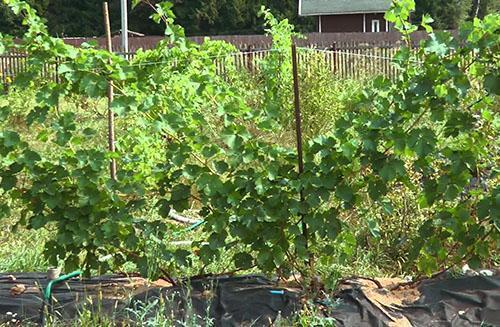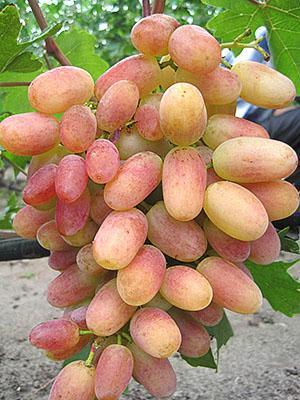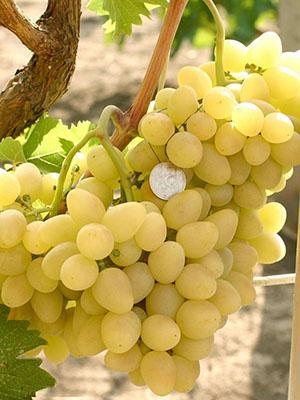Early ripeness grape varieties
 The first berries of the new harvest on grapes appear in late July or August. In varieties and hybrids showing such an early ripening period, the accumulation of sugars and the appearance of a characteristic taste in the berries occurs earlier than their true ripeness, and the seeds darken. And harvesting precedes the ripening of the shoots. Grape varieties of early maturity include plants in which the period from bud opening to harvest lasts no more than 115–120 days. A limited number of varieties demonstrate very early ripening, bearing fruit after 95–105 days. And in the main group, the growing season on average lasts from 105 to 115 days.
The first berries of the new harvest on grapes appear in late July or August. In varieties and hybrids showing such an early ripening period, the accumulation of sugars and the appearance of a characteristic taste in the berries occurs earlier than their true ripeness, and the seeds darken. And harvesting precedes the ripening of the shoots. Grape varieties of early maturity include plants in which the period from bud opening to harvest lasts no more than 115–120 days. A limited number of varieties demonstrate very early ripening, bearing fruit after 95–105 days. And in the main group, the growing season on average lasts from 105 to 115 days.
The specific terms of grape ripening depend not only on the variety, but also on the nutrition of the vine and care for the bush, climatic and weather conditions of cultivation.
With the right choice of planting material and compliance with all the rules of agricultural technology, early grape varieties will certainly delight the gardener with the first juicy berries of decent quality.
Description and photo of the grape variety Transformation

According to the description of the variety and the photo of the grape Transformation, the plant is capable of producing large conical or cylindrical clusters, the average weight of which is 700-1500 grams. In favorable years, there were cases of obtaining brushes weighing up to 2.5 kg. The Transfiguration is characterized by elongated oval pink berries weighing about 14 grams, up to 3.5 cm long with juicy fleshy pulp and inconspicuous skin. After collection, the brushes are well stored and can be transported.
This early grape variety demonstrates high yields, moderate disease resistance of this crop and high quality of the berries harvested. The bushes show the best results with an average pruning of 6-8 eyes.
Arcadia grapes
 This early table grape variety, ripening in 115 - 120 days, was obtained by Ukrainian breeders from the crossing of Cardinal and Moldova.
This early table grape variety, ripening in 115 - 120 days, was obtained by Ukrainian breeders from the crossing of Cardinal and Moldova.
The grapes form quite vigorous bushes with ripening, with proper pruning, shoots, of which up to 75% bear fruit. The variety is well compatible with most rootstocks used, survives winters at temperatures above –21 ° C and is quite resistant to many infections and downy mildew. With the danger of development oidium additional processing is needed. Thanks to the developed root system, the seedlings quickly enter the fruiting season.
The variety requires obligatory normalization of inflorescences and limitation to 8 of the number of shoots per square meter. A high-yielding grape variety of early maturity gives dense large clusters in the form of a truncated cone, weighing from 500 to 2000 grams. Arcadia has white or golden ovoid berries, weighing from 7 to 15 grams and up to 2.8 cm long. Like many high-yielding varieties, the fruits do not differ in sugar content, but with a slight acidity and juicy consistency, they demonstrate a pleasant refreshing taste.
The main advantage of Arcadia grapes is a consistently high yield and abundant ovary formation.
Laura grapes: description and photo of the variety
 Laura grape variety, which ripens in 110-115 days, was bred by Ukrainian breeders. Today, but already under the name Flora, the variety is included in the State Register of this country, and is grown not only here, but also in many areas of traditional viticulture in Russia.
Laura grape variety, which ripens in 110-115 days, was bred by Ukrainian breeders. Today, but already under the name Flora, the variety is included in the State Register of this country, and is grown not only here, but also in many areas of traditional viticulture in Russia.
Laura shoots ripen well. The bushes are resistant to mildew and gray rot, withstand frosts of –21 ° C, the crop suffers little with a lack of moisture. The variety actively forms ovaries, and on fast-growing rootstocks, yields are abundant, but the sweetness of such berries is lower. Short or medium pruning is recommended for the variety.
The early ripe grape variety Laura, according to the photo and description, gives cone-shaped, rather loose clusters, consisting of oval greenish berries, which receive a beautiful blush in the sun. The average mass of dense berries with balanced sufficient sweetness is 6-9 grams. The fruits adhere well to the hand, do not crumble and are easily transported.
Codryanka grape variety: description and photo
 Known for its early ripeness and high resistance to diseases of grapes, the Codreanca variety was obtained in Moldova and has the second name Black magic. The variety is resistant to temperatures down to -22 ° C and, with proper care, does not often suffer from mildew. The duration of the growing season of the variety is 110-118 days. During this time, clusters weighing from 500 to 1500 grams are tied and ripen on vigorous bushes. Formed from large, elongated-oval berries up to 3 cm in size and an average weight of about 7 grams.
Known for its early ripeness and high resistance to diseases of grapes, the Codreanca variety was obtained in Moldova and has the second name Black magic. The variety is resistant to temperatures down to -22 ° C and, with proper care, does not often suffer from mildew. The duration of the growing season of the variety is 110-118 days. During this time, clusters weighing from 500 to 1500 grams are tied and ripen on vigorous bushes. Formed from large, elongated-oval berries up to 3 cm in size and an average weight of about 7 grams.
According to the photo and description of the Codrianka grape variety, its berry has a rich dark purple with blue color and is covered with a clearly visible bluish bloom. Fruits with few seeds and thin skin ripen quickly, acquiring a simple pleasant taste with almost imperceptible acidity.
Libya grapes
 From the opening of the first buds to the ripening of berries on the bushes of grapes Libya of Ukrainian selection, 105-110 days pass. Even with a serious overload of the ovary, the shoots ripen well. Vigorous bushes survive winters with frosts below -21 ° C, are resistant to mildew and after preventive treatment with fungicides are not affected powdery mildew.
From the opening of the first buds to the ripening of berries on the bushes of grapes Libya of Ukrainian selection, 105-110 days pass. Even with a serious overload of the ovary, the shoots ripen well. Vigorous bushes survive winters with frosts below -21 ° C, are resistant to mildew and after preventive treatment with fungicides are not affected powdery mildew.
A grape variety of early maturity gives large, up to 25 cm in length, medium-density bunches. Oval-shaped pink berries exceed 2.8 cm in length, which remains in the fruits removed from the vine for up to a month. The berries of the hybrid Libya grape have a fleshy juicy consistency and an almost imperceptible skin. The pulp contains from 1 to 3 easily extracted seeds.
Description and photo of the Adler grape variety
 The early ripening grape variety Adler is the result of the work of Russian breeders from VNIIViV im. ME AND. Potapenko. Vigorous plants obtained from the crossing of the Talisman and Augustin varieties, in the Kuban conditions, bear fruit in mid-August, are resistant to gray rot and have an average resistance to oidium and mildew. In winter conditions it can withstand frosts down to –24 ° С.
The early ripening grape variety Adler is the result of the work of Russian breeders from VNIIViV im. ME AND. Potapenko. Vigorous plants obtained from the crossing of the Talisman and Augustin varieties, in the Kuban conditions, bear fruit in mid-August, are resistant to gray rot and have an average resistance to oidium and mildew. In winter conditions it can withstand frosts down to –24 ° С.
This grape variety forms bunches with an average density of up to 600 grams. According to the description of the variety and a photo of Adler grapes, it can be seen that oval large berries, reaching 3.5 cm in length, have an amber-yellow color and weigh about 12 grams. The consumer qualities of the crop are preserved for 30 days after ripening, while the berries are fleshy, easily accumulate sugar and have a good harmonious taste.
Veles grapes
 The hybrid form of Ukrainian origin ripens in 100–105 days, and sometimes in a shorter time. The seedless grape bred by V.V. Zagorulko, famous varieties Sofia and Rusbol. Veles forms bushes that give good growth, while the shoots ripen well and hibernate if winter temperatures do not fall below –21 ° C, otherwise they require shelter.The early grape variety is characterized by abundant formation of stepchildren, giving a second harvest in autumn.
The hybrid form of Ukrainian origin ripens in 100–105 days, and sometimes in a shorter time. The seedless grape bred by V.V. Zagorulko, famous varieties Sofia and Rusbol. Veles forms bushes that give good growth, while the shoots ripen well and hibernate if winter temperatures do not fall below –21 ° C, otherwise they require shelter.The early grape variety is characterized by abundant formation of stepchildren, giving a second harvest in autumn.
In the pink berries with a light nutmeg taste, only the rudiments of seeds are found, the skin is not felt at all when fresh grapes are consumed. Individual berries weigh about five grams.
On the shoots there are 2-4 inflorescences, the ovaries are actively formed, and the ripening brushes are extremely large. The weight of individual bunches of Veles grapes reaches three kilograms.
Description and photo of the grape variety Victor
 Differing in the early, from 100 to 105 days, maturity, the hybrid for table purposes was bred by V. Krainov from crossing the Kishmish radiant and Talisman varieties. More than half of the shoot length on vigorous bushes matures and can withstand cold temperatures down to –23 ° С. A promising grape variety demonstrates increased resistance to major crop diseases. Inflorescences are actively pollinated. As can be seen from the description and photo of the Victor grape variety, the plants form large, rather dense clusters weighing from 600 to 1000 grams.
Differing in the early, from 100 to 105 days, maturity, the hybrid for table purposes was bred by V. Krainov from crossing the Kishmish radiant and Talisman varieties. More than half of the shoot length on vigorous bushes matures and can withstand cold temperatures down to –23 ° С. A promising grape variety demonstrates increased resistance to major crop diseases. Inflorescences are actively pollinated. As can be seen from the description and photo of the Victor grape variety, the plants form large, rather dense clusters weighing from 600 to 1000 grams.
The berries in the clusters are very large, weighing about 12 grams. When the elongated oval berries are fully ripe, the pink color becomes more intense up to burgundy purple. From the bush, you can get up to 6 kg of fruits with a harmonious pleasant taste and an average thickness of the skin, which does not interfere with the use of fresh berries, but restrains wasps attracted by the aroma of grapes.
Grape Delight
 An early ripe grape variety belongs to table grapes and is distinguished by high cold resistance and immunity to diseases. The plant tolerates winters with frosts of -25 ° C, rarely affected by mildew, gray mold and powdery mildew. Under favorable weather conditions, before ripening, the berries on the Delight grapes take 110–120 days, while at least 65% of the shoots bear fruit, and most of the growth ripens well by the end of the growing season. For a plentifully fruiting bush, it is recommended to prune the vine into 6-10 eyes.
An early ripe grape variety belongs to table grapes and is distinguished by high cold resistance and immunity to diseases. The plant tolerates winters with frosts of -25 ° C, rarely affected by mildew, gray mold and powdery mildew. Under favorable weather conditions, before ripening, the berries on the Delight grapes take 110–120 days, while at least 65% of the shoots bear fruit, and most of the growth ripens well by the end of the growing season. For a plentifully fruiting bush, it is recommended to prune the vine into 6-10 eyes.
Delight grapes have large, medium friability bunches weighing from 500 to 2000 grams. As they ripen, the marketable oval berries weighing about 7 grams acquire a light golden hue and a light sun tan. The brushes are transported without loss of quality. Harmonious taste and dense, crunchy texture of berries lasts up to one and a half months.
The variety thrives when grown without additional shelter when grafted onto a vigorous stock, and also as a culture for arched trellises.
Julian grape
 An interesting hybrid form of very early maturity table grapes was obtained by V.U. Kapelyushny. High-yielding grapes ripen in 95-105 days from the moment the first buds open, tolerate frosts down to -24 ° C, with additional processing resists the main diseases of the culture and demonstrates a good growth rate and unpretentiousness.
An interesting hybrid form of very early maturity table grapes was obtained by V.U. Kapelyushny. High-yielding grapes ripen in 95-105 days from the moment the first buds open, tolerate frosts down to -24 ° C, with additional processing resists the main diseases of the culture and demonstrates a good growth rate and unpretentiousness.
Own-rooted Yulian grape seedlings are vigorous, root quickly and practically without loss. The planting material is easily compatible with most of the rootstocks. The resulting shoots ripen almost to their full length by the end of the season, however, to obtain high-quality large berries, this grape variety requires normalization at the stage of flowering and the formation of clusters.
Very large clusters on an elongated peduncle are distinguished by medium friability and weighing up to 3 kg. The berries are nipple-shaped, about 4 cm long and up to 2.8 cm wide. The color of ripe berries is pink, the skin is thin, almost imperceptible when bitten. Ripe berries, not eaten by wasps and other insects, have a crisp, dense texture and a harmonious taste with a predominant sweetness.